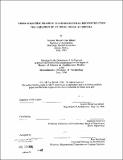| dc.contributor.advisor | Stanford Anderson. | en_US |
| dc.contributor.author | Bilsel, Selami Mesut Can | en_US |
| dc.date.accessioned | 2011-06-20T15:46:37Z | |
| dc.date.available | 2011-06-20T15:46:37Z | |
| dc.date.copyright | 1996 | en_US |
| dc.date.issued | 1996 | en_US |
| dc.identifier.uri | http://hdl.handle.net/1721.1/64534 | |
| dc.description | Thesis (M.S.)--Massachusetts Institute of Technology, Dept. of Architecture, 1996. | en_US |
| dc.description | Includes bibliographical references (leaves 75-79). | en_US |
| dc.description.abstract | The incomplete Temple of Didyma appeared in modern times as a constructed image, as an affirmation of the representative Greek temple. By the turn of the century the remains of the classical Didyma were rediscovered, the temple was redrawn and the site was literally and metaphorically "enframed." Reconstruction of the remains of classical antiquity provided beholders with the physical and aesthetic immediacy of a far distant past. Hence, the immediacy and tangibility of reconstructed images helped to differentiate between the world of the "original" configuration of the remains and that of their later existence. Given that the construction of architectural knowledge has rarely been questioned at Didyma, this study inquires into the codification of the remains of antiquity into the domain of the discipline of architecture, which ultimately differentiated the architectural product of a certain "golden age" from the historical processes in which it accumulated its meaning. The 1895-1896 "Beaux Arts" excavations and reconstruction seem to be the most representative example of such a codification. By the end of the 19th century reconstruction drawings represented the "unfinished" temple of Didyma in a complete form that has never been "achieved" in antiquity, while the excavations physically demolished the contemporary village surrounding the temple. Culminating with Hausoullier's and Pontremoli's representations, the reconstruction work metaphorically restarted the building at the point where it was interrupted in the late 4th century AD and transformed it into a finished, framed picture. Therefore, central to this study is a questioning of a 19th century scientific methodology in the uncovering and reassembling of architectural fragments which would ultimately take their place in the construction of an a priori image. But the study equally raises a more general question about the "framing" of the historical sites for "understanding" architecture and how this understanding might obscure the impetus of other historical and contextual concerns. In terms of historical interpretation, we have to clarify that the "modern" temple of Didyma exists today in the way it is represented. Just as the construction of the ideal image of Didyma has its historicity, the interpretation undertaken by this study is also bound by our own temporal world and takes a position vis-a.-vis the Beaux-Arts reconstruction. Beyond the aim of an "objective" reconstruction, this study intends to put the fragments of historical evidence together with later representations. Its aim, in other words, is to contribute to a "fusion" of discourses and interpretations in Western Anatolia. It is an attempt to claim the importance of site-specific concerns as opposed to all-encompassing, culture deterministic theories; an attempt for specificity without closure and inclusiveness without dispersion. | en_US |
| dc.description.statementofresponsibility | by Selami Mesut Can Bilsel. | en_US |
| dc.format.extent | 79 leaves | en_US |
| dc.language.iso | eng | en_US |
| dc.publisher | Massachusetts Institute of Technology | en_US |
| dc.rights | M.I.T. theses are protected by
copyright. They may be viewed from this source for any purpose, but
reproduction or distribution in any format is prohibited without written
permission. See provided URL for inquiries about permission. | en_US |
| dc.rights.uri | http://dspace.mit.edu/handle/1721.1/7582 | en_US |
| dc.subject | Architecture | en_US |
| dc.title | From scientific framing to architectural reconstruction : the creation of an ideal image at Didyma | en_US |
| dc.type | Thesis | en_US |
| dc.description.degree | M.S. | en_US |
| dc.contributor.department | Massachusetts Institute of Technology. Department of Architecture | |
| dc.identifier.oclc | 35953905 | en_US |
